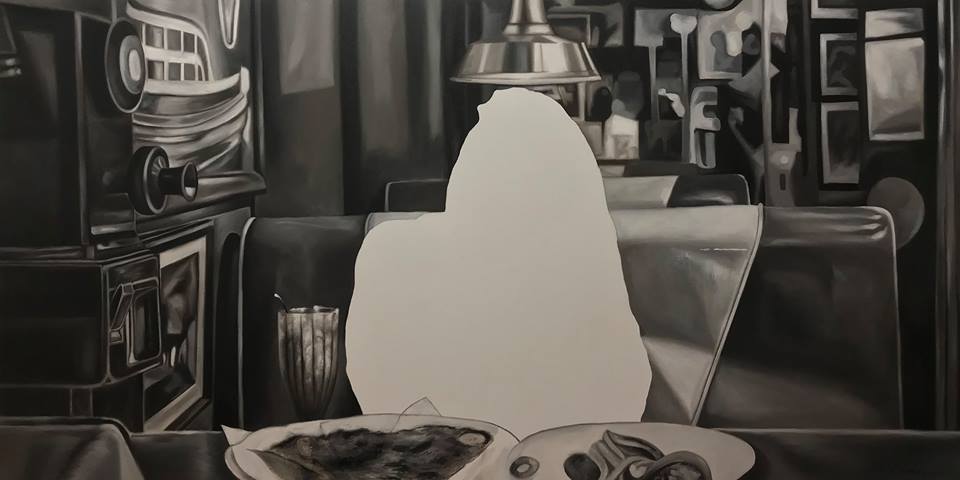
- Food and solitude are not meant to be taken together, at least not according to social norms dating back to the onset of high modernity. A table at a restaurant is meant to seat two at a minimum. Some places have even attempted to absolve diners of this predicament by offering artificial company: a massive stuffed Moomin plushie, perhaps? An actor in zombie make-up? A pretend boyfriend? A cat? Anything to distract oneself from the deafening silence that comes with taking a meal by one’s lonesome in a public place.
- While the discomfort and inability to enjoy eating alone are rarely about the food, the food does however have the capacity to magnify the experience and with it, the discomfort. Yet even if food is only meant to address physical needs, the void left by a diner’s absent companion shifts the sensation from the body to the mind. There is a name for this: the Spotlight Effect – in which individuals tend to overestimate the amount of attention and ridicule they suffer by being alone in public. This is not limited to eating, but to any activity that typically calls for some form of social engagement.
- Thank god for our phones then, and for the escape offered by the unseen online mass. Where the newspaper, radio, and television once offered solace from the anxiety of a table set for one, today’s lone diner can escape into the comforts of the web. Every day, an untold number of photographs are uploaded to social networks, with platforms such as Facebook, Twitter, and more notoriously (as far as meal photography goes), Instagram playing host to countless pictures of brunches, lunches, and avocado toasts. It is this same categorical cross between the photographic and voyeuristic that terms like “flat-lay” and oversharing have made their way into everyday vocabulary.
- Because we share these experiences—even through the superficial framing of a picture in an endless online scroll—we are never really alone. Still, consider how this same spectacle designed for the individuated space of the screen does not necessarily birth new connections. Rather, it only makes our connections—not only to food, but to each other—even more complex.
- The literature devoted to experience of eating alone is dense and rich with subjectivity. Solitude, if anything, can potentially kill one’s appetite, as described by the novelist Nathaniel Hawthorne. Of his experiences dining in Paris, Hawthorne wrote in his diaries of how he was, “[A]shamed to eat alone…It becomes the mere gratification of animal appetite…these solitary meals are the dismallest part of my present experience.”
- “Dismal” is infused by photorealist Adrian Evangelista in each of his works on the subject. The food, despite appearing in full color, floats otherworldly off a canvas done in shades of grey. These are meals demanding to be finished at once, magnified in importance by their acting as distractions from the shame of a world bearing all its eyes upon the solitary diner. At times bearing a strong resemblance to outtakes from a film noir set, Evangelista zooms in on the view of a diner clearly bothered by the fact of a meal going unshared, a view in which every object—a plate, a window, a coffee cup—become outsized with meaning and metaphor.
- There were however those who relished their solitude, understanding that being alone was not the same as being lonely. In 1889, the turn of the century and arguably the birth of the cityscape as we know it, the composer Haydn was reported in the Boston Daily Globe as having ordered a meal at hotel restaurant that could have fed five. Baffled at the sheer size of the Hungarian composer’s order, the hotel waiter allegedly told him, “But sir, the company is not come.” To which Haydn replied: “Pooh! De gompany! I am de gompany!”
- This other side of eating alone is captured in the work of Mek Yambao. While Evangelista meditates on the accompanying anxiety found on the flipside of all those carefully curated and flatlayed photos of perfectly plated meals, Yambao responds by taking a more whimsical turn. In her work, eating alone becomes a chance to be more honest with oneself – to order without fear of being judged, to lick one’s fingers, to express genuine delight or disgust through the smacking of lips or gagging without having to worry about being impolite.
- On the average, a person living in the contemporary moment, under neoliberal capitalism, will eat roughly 89,790 meals[1] before their death. Some of those meals will be taken alone, amidst actual Scientific reportage that eating alone is not only bad for business, but bad for your health. While these claims are backed by Scientific research, how useful is it to draw generalizations when an average person will eat close to a hundred thousand meals in their lifetime? This does not even account for the fact of hunger, the fact that the person with access to food is, in fact, a very lucky person to begin with.
- This is how Evangelista and Yambao paint a complex picture from a seemingly silly predicament. The experience of eating alone may at first appear easy to dismiss, but it is about recognizing the need to reclaim the mundane. Food is not only meant to nourish, it is meant to be savored, to teach us to sit back and enjoy the moment, alone or with friends, and always at one’s own pace.
[1] Computed based on an average lifespan of 82 years, multiplied by 3 meals a day, 365 days in a year: 82 x 3 x 365
Written for Table for One, two-artist show featuring the work of Mek Yambao and Adrian Evangelista. Metro Gallery, San Juan. December 8, 2018. The photo of Adrian Evangelista’s work is from the Facebook page Metro Gallery.